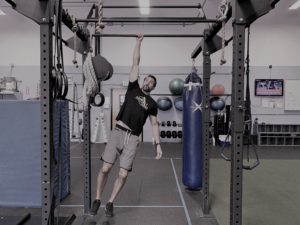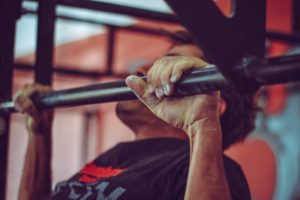How To Train For An Obstacle Course Race
 It is a loaded question of course. There are so many aspects that we can dive into when considering training for an obstacle course race. In this short post I will cover some of the main concepts you will need to consider in order to take on that race.
It is a loaded question of course. There are so many aspects that we can dive into when considering training for an obstacle course race. In this short post I will cover some of the main concepts you will need to consider in order to take on that race.
When looking at a training plan I like to keep things as simple as possible so it is easier to implement. Once you have the basics down, you can obviously add more. But I will assume you don’t have obstacles in your back yard and need to be able to train using what you would find in most gyms. If you have obstacles to practice on then you can always add those in.
In order to set up a training plan, let’s consider what attributes you will need in order to be successful. Since it is a race and you will spend most of the time running versus getting through obstacles, we must plan for running. In order to help with running and be able to conquer the obstacles in our way, we must be strong. We can include this next piece with our strength work, but since grip is such an important component to so many obstacles, we must plan to build significant grip strength. And finally we want to make sure our body is prepared for any obstacles we might face.
Let’s break each of these down one by one to help you set up the perfect training plan for your next obstacle course race.
1. Become A Better Runner
I will admit this took me longer than it should have to accept for myself. I wanted to be a strength athlete, but to compete in a sport like obstacle course racing you have to be a runner. If you view this as your weakest point, you will want this to make up a majority of your training. You might include 3-4 days of running per week, but it will depend on how much training you need for other areas. For the scope of this article, I am going to keep this basic so you can have an easy plan to implement. The first goal is to build endurance so you are prepared to handle the distance and time spent on your race. So if you are running a 10km race distance you will need to make sure you can build up to run that distance. Now since you aren’t just running you will also need to plan for additional time on your feet with the obstacles. If you haven’t run a race you won’t know exactly what you pace will be, but plan on an additional 50% of your normal 10km time. So if you can run a 10km in 60 minutes plan on spending at least 90 minutes on the course. This would be a minimum. It is very likely you will take longer.
Once you have build up enough aerobic capacity to handle the distance, your next goal would be to improve the pacing. This would be your threshold training were you are trying to hold higher intensities for longer. This can be achieved through interval training or tempo runs. The idea is to push your lactate threshold so you are more comfortable hitting these high intensities that you will probably see in the race. These workouts will consist of higher intensity efforts for time periods of as short at 30 seconds and all the way up to 20 minutes.
Finally you will want to prepare for the terrain you will see race day. Typically this will mean some trail running with appropriate levels of incline. This is where a lot of people get in trouble. They may have got some running in, but their legs just weren’t prepared for the incline and decline they saw on race day.
If you can combine all of the above each week you are on the path of a great running plan for your next OCR.
2. Get Strong
Before you just right into th e obstacles, make sure you build some strength first. If you don’t have the basic strength required for the different obstacles, no amount of practicing will help you. Work on building general strength in the essential movements. Once you hit minimum goals in strength you will see a dramatic improvement in your obstacle skill. For example, imagine how much easier it will be to train for monkey bars if you can perform a few pull ups first.
e obstacles, make sure you build some strength first. If you don’t have the basic strength required for the different obstacles, no amount of practicing will help you. Work on building general strength in the essential movements. Once you hit minimum goals in strength you will see a dramatic improvement in your obstacle skill. For example, imagine how much easier it will be to train for monkey bars if you can perform a few pull ups first.
In by book Fuel and Fire, I share some strength standards for different exercises that you can shoot for. But in general get as strong as you can with a few basic movements like squats, deadlifts, lunges, push ups, pull ups (or hangs), carries, and crawling. If your goal is to improve strength you will want to stick with more maximal loading for around 3-8 reps.
Once you build strength, then you can add in some metabolic strength workouts where you are going at a faster pace and trying to get your heart rate up during your strength workouts. But initially take your time. Building strength required heavier loads and adequate rest between exercises.
Another aspect I wanted to include here is power development. Strength is going to be important but we can’t forget about power. Not only do we need to be able to lift heavy things, we need to move quickly as well. It is important to include a variety of upper and lower body power drills. This can include upper body medicine ball throws and lower body jumping. Simple drills like this work very well as long as they are being performed explosively.
3. Grip Strength
Many of the drills that involve strength training discussed above will improve grip strength. Because it is such an important piece to training for an obstacle course race, I think we should discuss this further. A better grip will help you with carrying, climbing, and hanging obstacles. But not all grip is the same. We need different types of grip in different situations and we need our shoulder in different positions as we grip.
Let’s break it down into different types of grip first. The first type is a crush grip. This would be any exercise where you are trying to squeeze something hard. This is an easy one to incorporate into many different exercises. For example think of a DB Row. Instead of holding the DB, trying squeezing it as hard as you can while you are rowing. This intentional squeeze is great for improving crush strength. Next, we have support grip. This is where we hold an object or hang from something for an extended period of time. This would include farmer carries and dead hangs. Finally, we have pinch strength. This is where you squeeze an object between your thumbs and fingers. This type of grip is really strong in rock climbers for example. An exercise here would be pinching a plate and holding it or carrying it.
The second aspect to grip training is to alter your shoulder position. When you are doing an obstacle sometimes you need strength with your hands down, out in front of you, or over your head. So these are 3 variations you can to improve overall grip strength. Here is an example. For support grip we can use hanging exercises. But if we change the type of hang we can get the shoulder in different positions. Plus sometimes it is good to have options incase one position bothers you. Position one we can do a dead hang exercise. Position two can be a horizontal hang exercise. And position 3 can be a dip hold exercise. Slight variations of the same type of grip strength.
4. Obstacle Training
I intentionally wanted to discuss this aspect last. I know most want to jump right into training on obstacles, but if you aren’t working on the top three first you are likely to struggle on many of the obstacles. When you are ready we can add in this final piece. Like I mentioned, if you have access to home or gym obstacle set ups, you are going to practice on those. If not you will do the best you can to work on the elements of each obstacle.
If we simplify each obstacle, we can see the most of them require running, carrying, crawling, climbing, and hanging. For your obstacle specific workouts, this is a great place to start. Choose one exercise from each of these categories. Typically we can put these in a circuit fashion since that is what the race is going to be like.
Here might be an example circuit you could perform for 3-4 rounds:
- Run 400m
- Sandbag Carry x 1 Min
- Reverse Bear Crawl x 20m
- Jumping Muscle Ups x 8
- Hanging Shoulder Taps x 5ea
My caution for these types of workouts is to use sparingly. This should be one workout you are performing. Not all of them. Make sure you are still including your running and strength workouts with these style of workouts.
Hopefully this helps you get the idea of what it takes to train for a race. We can dig deeper into each category, but this is a great starting point. If you need help putting together your training plan, check out my free sample workout that will give you a great starting point in your training.

